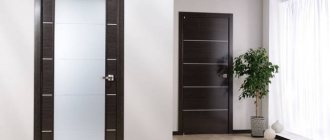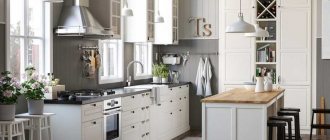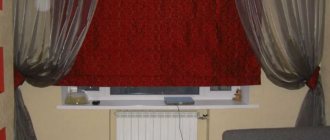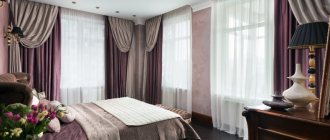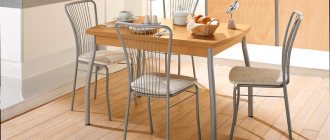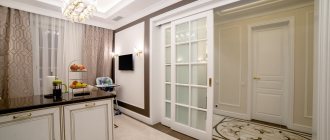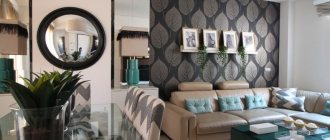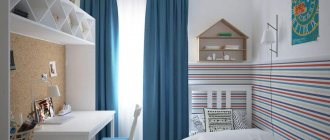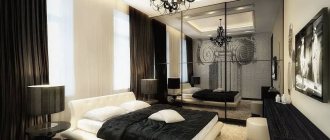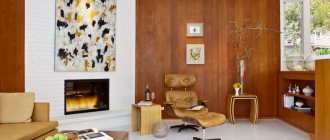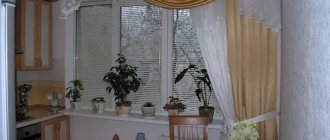A win-win option is white skirting boards with the same door and window frames. They can “make friends” with each other even colors that seem inappropriate at first glance, enliven the atmosphere, give it a solemn and elegant look.
- White plinth can be used in any room - in the living room and kitchen, in the bathroom or in the hallway.
- The plinth can be wide or narrow, in one line or in two.
- A white plinth emphasizes the geometry of the room, highlights the planes of the walls and changes the perception of volume - the room seems lighter and airier.
Let's consider several options for combining baseboards, floors and doors when decorating an apartment, and their role in shaping the interior.
The door and floor are dark, the baseboard is light
If you want to combine dark flooring colors with dark door panels, designers recommend choosing light colors for baseboards and trim. This will visually lighten the room and make it more “transparent”.
The combination of the floor and doors of the same color will look harmonious, and a contrasting baseboard will help avoid monotony. Please note that the width of the linear elements - both the plinth, platbands, and cornices - plays an important role in the visual perception of such a solution. In this case, it should be at least eight centimeters. This color scheme looks very elegant and suits any room in the apartment.
How to choose a plinth for the floor, what to focus on by color
The final stage when performing any work with floor coverings is the installation of skirting boards around the perimeter of the room. However, not everyone knows how to choose a baseboard for the floor so that it not only fulfills its practical functions, but also serves as a decorative element that complements the interior of the room.
We will talk further in the material, supplemented with photos and videos, about how to choose a floor plinth, what to look for when purchasing, as well as what nuances should be taken into account when working with various types of coatings. The main purpose of skirting boards, for which they were invented, is to mask technological gaps between the floor covering and walls, as well as to give corners aesthetics.
At the same time, an equally important aspect of using floor skirting boards is placing accents on certain objects, disguising some objects, if necessary, in a word, giving the interior completeness
The main purpose of skirting boards, for which they were invented, is to mask technological gaps between the flooring and walls, as well as to give corners aesthetics. At the same time, an equally important aspect of using floor skirting boards is placing accents on certain objects, disguising some objects, if necessary, in a word, giving the interior completeness.
Some designers use colors similar to baseboards to hide swing doors, for which they apply it along the bottom of the door leaf.
There are many types of skirting boards made from a variety of materials. In particular, skirting boards are made from plastic, MDF, LDF, gypsum, glass, mosaic, porcelain stoneware and natural wood veneer or solid wood (read: “Porcelain stoneware skirting boards - types and advantages”). And yet the material does not play the most important role if you decide which skirting board to choose for the floor. Very important factors are also: the shape, size and color of these decorative elements, which we will discuss in more detail below.
Dark floor
It should be noted right away that a dark floor is considered not only brown or black, but also dark shades of other colors.
The dark color of the flooring brings a feeling of warmth and comfort to the interior, but at the same time visually it noticeably conceals the space. Therefore, it is more logical to use dark floors in large rooms, adding glass and metal objects to them. When choosing, you need to remember that balance must be maintained: dark floor – light walls, otherwise the room will instantly turn into a gloomy dungeon.
Features of use
- Dark surfaces (except black) get dirty less and are more practical. But they also need regular care.
- The combination of “dark floor – light furniture” is considered common, but a number of designers recommend choosing objects that are only a few tones lighter than it for a dark floor.
- If such an interior seems gloomy to someone, creating a painful atmosphere, then these people can use the well-known design maneuver: combining a dark floor and light walls in the interior. Furniture in this case can be of any color, because such an interior is characterized by “omnivorousness”.
Advantages
- Many dark shades have a positive effect on a person’s well-being, they are calming and do not cause irritation. It has been noted that a light kitchen with a dark floor even helps to digest food better.
- The dark floor adds seriousness and solidity to the interior.
- It averages out the proportions of oversized accessories.
Flaws
- It is better not to make a dark floor in a room where there is not enough natural light, but, on the other hand, if the sun's rays directly hit the floor, they will highlight the slightest defects in the coating, and even a small amount of dust on its surface will immediately become noticeable.
- On a dark glossy finish, all the stains from washing the floor will be clearly visible. Therefore, after washing such a floor will have to be additionally polished.
- Dark varnish is very easy to scratch, and all the smallest scratches will immediately become visible.
The final effect greatly depends on the correct selection of color tone, which can be understood by comparing a dark floor and light doors.
- Shades of chocolate will make the interior expensive and cozy due to their warmth.
- Thanks to the black color, the home will acquire a modern individuality and even extravagance.
- Somewhat aloof dark gray tones will make the atmosphere cooler.
Light baseboard, dark floor, bright door
The colors of the floor, baseboards and doors can be chosen in such a way as to create a spectacular and original combination that serves as an independent interior decoration. For example, with a standard dark floor covering and light wall decoration, using a white baseboard and a bright color for the door leaf will create an interesting artistic image.
A rich color will allow you to concentrate attention on the entrance area, so this solution is usually chosen for decorating the interiors of kitchens, hallways, and halls. Such a contrasting combination of baseboards, floors and doors will look good in pop art style, as well as modern minimalist styles.
Criteria for choosing floor colors
Assess the height of the ceiling and decide whether you can afford dark colors on the floor. If the ceilings are low and the rooms are small, then the total area of the room will be squeezed by the dark floor. In this case, you should select a floor covering of a light shade - white, light gray, golden, sunny. Analyze the overall palette of the room and choose the color of the floors and walls in harmony
It is important not to make mistakes with the selection, not to mix everything together and not to spoil the picture of the decoration. Negative examples:
- bright orange-gold and blue;
- purple and light green;
- blue and pink;
Decide what color to choose the baseboard. It should frame the floor and not disrupt the design. If the room is small, then a contrasting option will create an imaginary frame and visually reduce the space. The color of the baseboard can be wood or plastic, they can be marble or granite - for every taste!
How to choose the color of the baseboard
Ideally, the baseboard is matched to the floor covering. And a textured pattern also works best if it is of the same direction.
- For example, for a wooden floor, it is best to choose a wooden type or its PVC equivalent.
- Plastic carpet matches, and it is more interesting to choose contrasting shades - not tone on tone, but as a highlighting frame.
- Under tiles, of course, it is best to use a ceramic option from the same collection as the tile itself. Color is an alternative to frieze.
- The self-leveling floor allows you to vary the choice, which depends on the chosen design.
The baseboard and floor are light, the door is dark
If the doors have a dark color with light floors, then the baseboard should be chosen in light shades. But there are no strict restrictions for platbands; they may well be as dark as the door.
This combination will be most harmoniously perceived in large rooms - living rooms, halls. A small room will be “crowded” by a large dark spot of the door, so for such rooms it is better to choose other color combinations of the floor and doors. This design is best suited for the neoclassical style if it is implemented in a country house.
Light doors and dark floors. How to beat dark doors in the interior
Simply placing a dark door in the interior—entrance or interior—and admiring it will not work. We need a complete idea, a certain thought that the designer is trying to convey.
You need to consider the color of the walls:
- on light wallpaper, a dark door will stand out and inevitably become an accent;
- on dark ones, on the contrary, it will be completely lost and invisible.
When combined with bright colors it will give noticeable contrast, regardless of whether they are light or dark. And in combination with pastel, delicate colors, the contrast will be even stronger - this can be used if you want to place a strong emphasis on the door.
You need to consider the color of the furniture:
- the dark fabric will contrast with light furniture - it will be effective if you make the entire interior around it uniformly light or dark;
- dark furniture will go well with the door.
You can combine the shade of furniture with the shade of the door not by color, but by its thermal characteristics. That is, if the door is a warm shade, then the door should be a warm shade. Otherwise, neither adequate contrast nor a related combination will work.
You need to consider the color of the door itself:
- black door in the interior. An excellent basis for contrasts. If you combine it with an all-white design, it will become the brightest accent, although the interior will look strict and even cold. To liven it up, you can add bright colors in small accents - in paintings, in textiles, in photographs. If you combine it with a black floor and white decoration, the effect will be less pronounced, but close. If combined with a dark design, it will look gloomy. And if with bright colors, it’s very impressive. This combination is good for modern styles, for a corridor or hallway, but bad for a bedroom or nursery;
- dark grey. An absolutely neutral color that depends entirely on the surroundings. You can fit it anywhere, even make an accent on the door - it will look equally advantageous;
- dark brown. Can be cold or warm. It also looks neutral and can be combined with anything, but is especially suitable for classic styles.
You can add decorations to the door - carvings, moldings, colored trim, glass inserts - or leave it in its original simplicity.
Common combinations with a dark door look like this:
- black door plus white floor, white walls, ceiling, large window, black furniture. In such a monochrome interior, any room except the children's room looks very good. The main charm of the interior is given by bright accents, which you cannot do without: a painting on the wall, a bright blanket on the sofa, a flower pot with a noticeable ornament, a bookcase with neatly selected books. Instead of a black door, you can take any other dark color, but it will not look so impressive;
- dark brown door, floor of a similar shade, light (blue, for example) walls, light ceiling, brightly colored (or with bright accents) furniture. Allows you to create an interior in a classic style - for example, Scandinavian can be decorated in these colors if you add handmade textiles and seascapes;
- a black door plus a black floor, walls of a bright color (blue, for example) interspersed with other bright colors (designed, for example, in the form of graffiti or paintings in the genre of modern art), a ceiling that is a continuation of the walls in color, and black furniture. It is important that the room is very spacious and very bright, otherwise the impression will be oppressive. It is also important that among the accents on the walls there are light shades. You can decorate a loft in these colors - just add a leather sofa, a bar counter and spotlights to complete the stylistic solution. The door color can be changed to gray, but not dark brown;
- dark brown door and golden floor in a shade matching the door, pastel colored walls, light ceiling. A large window is a must. These colors are good for decorating a kitchen to make it seem spacious. You can add paintings or graffiti to the walls, depending on the style (necessarily bright colors). You can hang bright curtains or place a flower on the windowsill.
When all 3 elements are in the same tone
And although interior fashion is constantly changing, the law on the color combination of doors, floors and baseboards remains unchanged. Therefore, if the flooring is made in reddish, amber or yellow, then it is better to choose doors and baseboards in the same color spectrum. Moreover, you can choose other colors, but they should be in the same warm range. The same rule should work for cool tones. If the floor and baseboard are made in graphite, blue or purple, then the door should only be in the cold spectrum. But there is one important point to consider here.
A person perceives the interior in a vertical direction. Therefore, light colors should be located closer to the ceiling, and darker shades on the floor.
The colors of finishing materials must be the same tone
